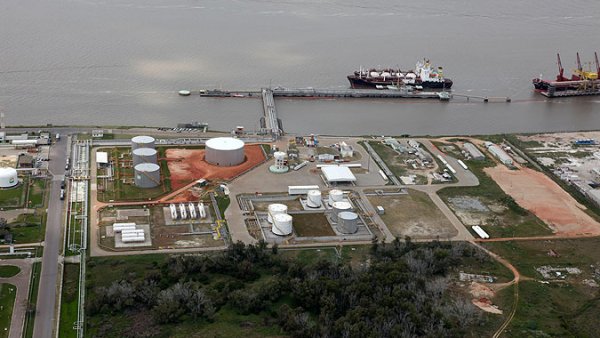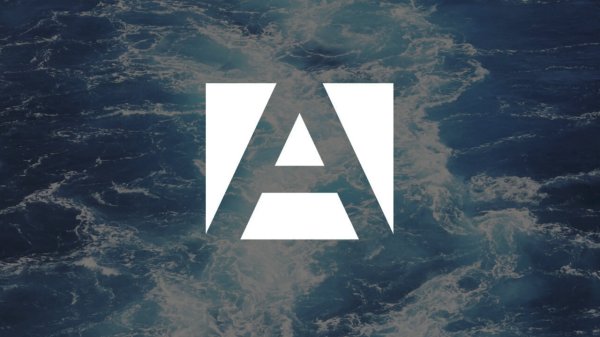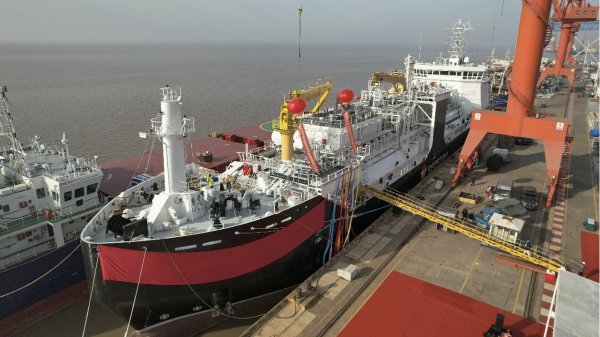$5.2 million net loss for barge operator
$9.1m drop in net income is attributed to decrease in net voyage revenue.
US barge operator K-Sea Transportation Partners L.P. has today reported a $9.1 million decrease in net income for its first fiscal quarter ended September 30, 2009.
Net loss for the three months ended September 30, 2009 was $5.2 million, or $0.29 per share, a decrease of $9.1 million compared to net income of $3.9 million, or $0.19 per share, for the three months ended September 30, 2008.
K-Sea said the decrease was primarily a result of the $4.5 million decrease in Earnings before interest, taxes, depreciation and amortization (“EBITDA”) and a $6.1 million increase in depreciation and amortization expense, offset by a $1.7 decrease in interest expense due to lower average debt balances and interest rates compared to the first quarter of fiscal 2008.
EBITDA for the first quarter of fiscal 2010 was $18.2 million, a decrease of $4.5 million, or 20%, compared to $22.7 million in the same quarter last year.
K-Sea said the decrease in EBITDA resulted from a $5.2 million decrease in net voyage revenue, which is attributable to fewer working days for the company's single-hull vessels and a reduction in its average daily rate due to operating certain vessels, mainly single-hulls, under storage contracts in its waste water treatment facility at lower rates.
The company reported an operating loss of $1.3 million, a decrease of $11.2 million compared to $9.9 million of operating income for the three months ended September 30, 2008. K-Sea said the operating loss resulted from a $5.9 million asset impairment charge on its single-hull vessels.
Operating income, before asset impairment charges, was $4.6 million, a decrease of $5.3 million, or 54%, compared to the first fiscal quarter ended September 30, 2008.
Due to customer preference for double-hull vessels, K-Sea says it has taken a number of our single-hull vessels out of the market and has either retired or sold them, or utilized them as storage vessels. Additionally, other revenue decreased by $2.7 million mainly due to the expiration of time charter contracts on tugboats acquired in June 2008 and the current soft market to utilize those vessels, and the recognition of a $0.5 million gain in the first quarter of fiscal 2008 on the settlement of an early termination of a charter contract. This decrease was partially offset by a $1.6 million reduction in vessel operating expenses and a $1.0 million reduction in general and administrative expenses, substantially as a result of cost reduction efforts the company implemented.
Commenting on the results, President and CEO Timothy J. Casey said, “we are disappointed with our first quarter results and lower distribution rate. In response to an unexpected decrease in demand, and in addition to our constant focus on maximizing utilization and rates for our assets, we have stepped up our efforts to minimize costs and capital expenditures, without compromising the quality of service we deliver to our customers or the safety of our employees and the environment.”
Casey added, “Upon management’s recommendation, our Board determined that our quarterly distribution would be $0.45 per unit based upon our operating results for the first fiscal quarter and our expectation that current market conditions may prevail for at least the next several quarters. The absence of any meaningful recovery in petroleum demand is causing further reductions in refinery utilization and thus further reductions in waterborne product movements, including a reduction in the number of new term charters. Single-hulled tonnage continues to be available at lower rates than in the same period last year for our barges that are not operating on period charters. We believe that the single-hulls, which are mandated to be phased out by 2014, are now commercially obsolete as customers are unwilling to accept this equipment, in light of the availability of double-hulled vessels.
“Given the current and expected market conditions, we expect to phase out our single-hulls in the near-term. Our depreciation and amortization expense in the first fiscal quarter includes an asset impairment charge of $5.9 million in respect of our single-hull equipment. The early phase-out will result in a reduction of $1.4 million per year in our provision for maintenance capital expenditures and should therefore increase our annual distributable cash flow.
“We remain optimistic about the long-term prospects for our Company. We mentioned this in August, but we want to stress again where K-Sea stands in the market for waterborne transportation of refined petroleum products. We focus on transporting cargoes in the range of 20,000 to 150,000 barrels; 28% of this capacity are single-hull units. As mentioned earlier, there has been a noticeable trend for customers to increasingly prefer double-hull units over single-hulls. If all barges currently contracted to be constructed are in fact built and placed into service, and if all existing single-hulls are removed from service, total capacity in this size range would decline by approximately 18%. As the largest operator of barges in this size range, our market position would be enhanced. Thus, we believe our modern fleet, broad geographic presence, blue chip customer base and team of highly skilled employees will enable K-Sea to emerge from the current economic downturn in an even stronger position in our market.
“Regardless of the timing of the recovery in our markets, our results in our fourth fiscal quarter ending June 30, 2010 will reflect a positive impact of the upcoming delivery of our final two incremental newbuildings, the DBL 185 and the DBL 106. Both units will operate under long-term charters already fixed on terms that will be accretive to our results.”
Net loss for the three months ended September 30, 2009 was $5.2 million, or $0.29 per share, a decrease of $9.1 million compared to net income of $3.9 million, or $0.19 per share, for the three months ended September 30, 2008.
K-Sea said the decrease was primarily a result of the $4.5 million decrease in Earnings before interest, taxes, depreciation and amortization (“EBITDA”) and a $6.1 million increase in depreciation and amortization expense, offset by a $1.7 decrease in interest expense due to lower average debt balances and interest rates compared to the first quarter of fiscal 2008.
EBITDA for the first quarter of fiscal 2010 was $18.2 million, a decrease of $4.5 million, or 20%, compared to $22.7 million in the same quarter last year.
K-Sea said the decrease in EBITDA resulted from a $5.2 million decrease in net voyage revenue, which is attributable to fewer working days for the company's single-hull vessels and a reduction in its average daily rate due to operating certain vessels, mainly single-hulls, under storage contracts in its waste water treatment facility at lower rates.
The company reported an operating loss of $1.3 million, a decrease of $11.2 million compared to $9.9 million of operating income for the three months ended September 30, 2008. K-Sea said the operating loss resulted from a $5.9 million asset impairment charge on its single-hull vessels.
Operating income, before asset impairment charges, was $4.6 million, a decrease of $5.3 million, or 54%, compared to the first fiscal quarter ended September 30, 2008.
Due to customer preference for double-hull vessels, K-Sea says it has taken a number of our single-hull vessels out of the market and has either retired or sold them, or utilized them as storage vessels. Additionally, other revenue decreased by $2.7 million mainly due to the expiration of time charter contracts on tugboats acquired in June 2008 and the current soft market to utilize those vessels, and the recognition of a $0.5 million gain in the first quarter of fiscal 2008 on the settlement of an early termination of a charter contract. This decrease was partially offset by a $1.6 million reduction in vessel operating expenses and a $1.0 million reduction in general and administrative expenses, substantially as a result of cost reduction efforts the company implemented.
Commenting on the results, President and CEO Timothy J. Casey said, “we are disappointed with our first quarter results and lower distribution rate. In response to an unexpected decrease in demand, and in addition to our constant focus on maximizing utilization and rates for our assets, we have stepped up our efforts to minimize costs and capital expenditures, without compromising the quality of service we deliver to our customers or the safety of our employees and the environment.”
Casey added, “Upon management’s recommendation, our Board determined that our quarterly distribution would be $0.45 per unit based upon our operating results for the first fiscal quarter and our expectation that current market conditions may prevail for at least the next several quarters. The absence of any meaningful recovery in petroleum demand is causing further reductions in refinery utilization and thus further reductions in waterborne product movements, including a reduction in the number of new term charters. Single-hulled tonnage continues to be available at lower rates than in the same period last year for our barges that are not operating on period charters. We believe that the single-hulls, which are mandated to be phased out by 2014, are now commercially obsolete as customers are unwilling to accept this equipment, in light of the availability of double-hulled vessels.
“Given the current and expected market conditions, we expect to phase out our single-hulls in the near-term. Our depreciation and amortization expense in the first fiscal quarter includes an asset impairment charge of $5.9 million in respect of our single-hull equipment. The early phase-out will result in a reduction of $1.4 million per year in our provision for maintenance capital expenditures and should therefore increase our annual distributable cash flow.
“We remain optimistic about the long-term prospects for our Company. We mentioned this in August, but we want to stress again where K-Sea stands in the market for waterborne transportation of refined petroleum products. We focus on transporting cargoes in the range of 20,000 to 150,000 barrels; 28% of this capacity are single-hull units. As mentioned earlier, there has been a noticeable trend for customers to increasingly prefer double-hull units over single-hulls. If all barges currently contracted to be constructed are in fact built and placed into service, and if all existing single-hulls are removed from service, total capacity in this size range would decline by approximately 18%. As the largest operator of barges in this size range, our market position would be enhanced. Thus, we believe our modern fleet, broad geographic presence, blue chip customer base and team of highly skilled employees will enable K-Sea to emerge from the current economic downturn in an even stronger position in our market.
“Regardless of the timing of the recovery in our markets, our results in our fourth fiscal quarter ending June 30, 2010 will reflect a positive impact of the upcoming delivery of our final two incremental newbuildings, the DBL 185 and the DBL 106. Both units will operate under long-term charters already fixed on terms that will be accretive to our results.”

|
IMO approves pricing mechanism based on GHG intensity thresholds
Charges to be levied on ships that do not meet yearly GHG fuel intensity reduction targets. |
|
|
|
||

|
VARO Energy expands renewable portfolio with Preem acquisition
All-cash transaction expected to complete in the latter half of 2025. |
|
|
|
||

|
NYK trials biofuel in milestone coal carrier test
Vessel is used to test biofuel for domestic utility company. |
|
|
|
||

|
H-Line Shipping orders LNG bunkering vessel
Vessel with 18,000-cbm capacity to run on both LNG and MDO. |
|
|
|
||

|
How to engineer and manage green shipping fuels | Stanley George, VPS
Effective management strategies and insights for evolving fuel use. |
|
|
|
||

|
Swedish government bans scrubber wastewater discharges
Discharges from open-loop scrubbers to be prohibited in Swedish waters from July 2025. |
|
|
|
||

|
MAN Energy Solutions achieves 100% load milestone for ammonia engine
Latest tests validate fuel injection system throughout the entire load curve. |
|
|
|
||

|
Petrobras secures ISCC EU RED certification for B24 biofuel blend at Rio Grande
Blend consisting of 24% FAME is said to have been rigorously tested to meet international standards. |
|
|
|
||

|
Stolt-Nielsen to fully control Avenir LNG with acquisition
Share purchase agreement to buy all shares from Golar LNG and Aequitas. |
|
|
|
||

|
Bureau Veritas supports launch of CIMC SOE's LNG bunkering vessel
Handover of Seaspan Energy's cutting-edge 7,600-cbm vessel completed. |
|
|
|
||
Related Links
- · K-Sea announces public offering of common stock [Insights]
- · Barge operator posts 60% drop in profit [Insights]
- · Barge operator reports drop in profit [Insights]
- · Barge operator reports profit decline [Insights]
- · United States [Directory]

